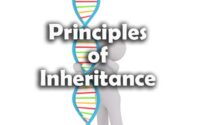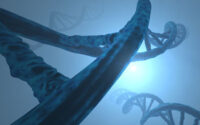Molecular Basis of Inheritance
1. Which of the following RNAs should be most abundant in animal cell?
A. r-RNA
B. t-RNA
C. m-RNA
D. mi-RNA
2. The final proof for DNA as the genetic material came from the experiments of-
A. Griffith
B. Hershey and Chase
C. Avery, Mcleod and McCarty
D. Hargobind Khorana
3. During DNA replication, Okazaki fragments are used to elongate-
A. The leading strand towards replication fork.
B. The lagging strand towards replication fork.
C. The leading strand away from replication fork
D. The lagging strand away from the replication fork
4. DNA fragments are—
A. positively charged
B. negatively charged
C. neutral
D. either positively or negatively charged depending on their size
5. The association of histone H1 with a nucleosome indicates—
A. Transcription is occurring
B. (b) DNA replication is occurring
C. The DNA is condensed into a Chromatin Fibre
D. The DNA double helix is exposed
6. If there are 999 bases in an RNA that codes for a protein with 333 amino acids, and the base at position 901 is deleted such that the length of the RNA becomes 998 bases, how many codons will be altered?
A. 1
B. 11
C. 33
D. 333
7. DNA dependent RNA polymerase catalyses transcription on one strand of the DNA which is called the—
A. template strand
B. coding strand
C. alpha strand
D. antistrand
8. The equivalent of a structural gene is—
A. Muton
B. Cistron
C. Operon
D. recon
9. Taylor conducted the experiments to prove semi-conservative mode of chromosome replication on—
A. Vinca rosea
B. Vicia faba
C. Drosophila melanogaster
D. Coli
10. Which of the following rRNAs acts as structural RNA as well as ribozyme in bacteria?
A. 55 rRNA
B. 185 rRNA
C. 23S rRNA
D. 5.85 rRNA
11. A molecule that can act as a genetic material must fulfill the traits given below, except
A. it should be able to express itself in the form of ‘Mendelian characters‘
B. it should be able to generate its replica
C. it should be unstable structurally and chemically
D. it should provide the scope for slow changes that are required for evolution
12. A complex of ribosomes attached to a single strand of RNA is known as—
A. Polypeptide
B. okazaki fragment
C. polysome
D. polymer
13. Which of the following is required as inducer (s) for the expression of Lac operon?
A. Lactose
B. Lactose and Galactose
C. Glucose
D. Galactose
14. Which one of the following is the starter codon?
A. UAA
B. UAG
C. AUG
D. UGA
15. Which of the following is not required for any of the techniques of DNA fingerprinting available at present?
A. Restriction enzymes
B. DNA-DNA hybridisation
C. Polymerase chain reaction
D. Zinc finger analysis
16. If the sequence of bases in the coding strand of a double stranded DNA is 5′-GTTCGAGTC-3′, the sequence of bases in its transcript will be—
A. 5′-GACUCGAAC-3′
B. 5′-CAAGCUCAG-3′
C. 5′-GUUCGAGUC-3‘
D. 5′-CUGAGCUUG-3′
17. Some of the steps of DNA fingerprinting are given below. Identify their correct sequence from the options given.
A. Electrophoresis of DNA fragments.
B. Hybridisation with DNA probe
C. Digestion of DNA by restriction endonucleases
D. Autoradiography
E. Blotting of DNA fragments to nitrocellulose membrane
A. C—A—B—E—D
B. C—A—E—B—D
C. A—E—C—B—D
D. A—C—E—D—B
18. Consider the statements regarding lac operon and choose the correct option.
(i) Lactose is the substrate for the enzyme beta-galactosidase and regulates ‘switching on and off‘ of the operon.
(ii) Lac operon consists of three regulatory genes.
(iii) Lac operon consists of one structural gene.
(iv) Regulation of /ac operon by repressor referred to as positive regulation.
A. (i) and (ii) only are correct
B. (iii) and (iv) only are correct
C. (i) only is correct
D. (iv) only is correct.
19. The ‘variable number of tandem repeats used as a probe in DNA fingerprinting is—
A. expressed sequence tag
B. satellite DNA
C. bacterial artificial chromosome
D. restriction enzyme
20. If the total amount of adenine and thymine in a double stranded DNA is 55%, the amount of guanine in this DNA will be –
A. 45%
B. 27.5%
C. 25%
D. 22.5%
21. The scientist (s) who performed experiments with heavy isotopes of nitroen to prove that replicates semi conservatively is /are—
A. Fredrick Griffith
B. Watson and Crick
C. Taylor
D. Meselson and Stahl
22. Find the correctly matched enzyme with the rRNAs they transcribe-
I. RNA polymerase I-285, 18S and 5.85 rRNAs
II. RNA polymerase III-28S, 18$ and 5.85 rRNAs
III. RNA polymerase II—tRNA, 5s rRNA and snRNAs
IV. RNA polymerase II—hnRNA
A. l and II
B. only II and III only
C. l only
D. l and IV only
23. The terminator/stop condons UGA, UAG and UAA—
A. initiate translation
B. do not code for any amino acids
C. code for only one amino acid
D. initiate transcription
24. If the four bases of DNA have to code for twenty amino acid, the code should constitute a combination of bases. This was proposed by—
A. Rosalind
B. Har Gobind Khorana
C. George Gamow
D. Marshall Nirenberg
25. Assertion : In Eukaryotes, replication and transcription occur in the nucleus but translation occurs in the cytoplasm.
Reason : mRNA is transferred from the nucleus to the cytoplasm where ribosomes and amino acids are available for-protein synthesis.
A. Assertion is true but reason is false
B. Assertion is false but reason is true
C. Both assertion and reason are true but reason is not the correct explanation for assertion
D. Both assertion and reason are true and reason is the correct explanation for assertion.
26. Which one of the following does not follow the central dogma in molecular biology?
A. HIV
B. E.Coli
C. Mucor
D. Chlamydomonas
27. E.CoIi bacteria grew in 15NH4Cl medium for several generations are allowed to grow in 14NH4Cl medium. After 2 generations, the bacteria are isolated from the medium and DNA of bacteria centrifuged in CsCl. The result of the density gradient of DNA is —
A. both heavy and light DNA
B. only hybrid DNA
C. both hybrid and light DNA
D. both hybrid and heavy DNA
28. Read the following statements carefully and choose the correct statements.
A. In a transcription unit, the promoter located at the 5‘ end of coding strand.
B. The single strand DNA having the polarity 5′ —> 3.
C. RNA polymerase binds to the operator during transcription.
D. Single base DNA differences occur in human are called Single Nucleotide Polymorphism (SNPs)
A. Statements B and D
B. Statements A and B
C. Statements A and D
D. Statements B and C
29. Which of the following set of options is used in translation?
A. hnRNA, tRNA, rRNA
B. mRNA, tRNA, rRNA
C. mRNA, tRNA, hnRNA
D. hnRNA, rRNA, tRNA
30. The process of transfer of genetic information from DNA to RNA is called-
A. Transcription
B. Translation
C. Replication
D. degeneracy
31. Satellite DNA is important because it—
A. does not code for proteins and is same in all members of the population
B. codes for enzymes needed for DNA replication
C. codes for proteins needed in cell cycle
D. shows high degree of polymorphism in population and also the same degree of polymorphism in an individual, which heritable from parents to children.
32. Select correct combination of statements for DNA fingerprinting.
(i) It is ELISA based technique.
(ii) It is PCR based technique.
(iii) It is used by forensic scientists.
(iv) It is based on the fingerprint of the individual
(v) It is a test for paternity
A. (i), (ii) and (iii)
B. (ii), (iii) and (v)
C. (i), (iv) and (v)
D. (i), (iii) and (iv)
33. What will be the percentage of guanine in a DNA molecule having 20% adenine?
A. 20%
B. 30%
C. 40%
D. 60%
34. Central dogma in molecular biology is—
A. RNA -> DNA -> Protein
B. DNA -> RNA -> protein
C. RNA —> Protein —> DNA
D. DNA —> Protein —-> RNA
35. Lactose (Lac) Operon is regulated by —
A. Lac repressor only
B. Lac repressor and CAP—cGMP complex
C. Lac repressor and CAP-cAMP complex
D. CAP-cAMP and CAP—cGMP complex
36. In the double-helical structure of DNA, the pitch of the helix is-
A. 3.4 nm
B. 0.34 nm
C. 6.6 nm
D. 34 nm
37. Microsatellites are-
A. repetitive DNA sequences
B. EsTs
C. YAC
D. UTR
38. A molecule to act as a genetic material has the following properties—
(i) should be able to replicate
(ii) should be structurally more stable
(iii) should be more reactive and labile
(iv) should provide scope for slow changes.
Choose the correct option.
A. (i), (ii) and (iii) are correct
B. (iii) alone is correct
C. (iii) and (iv) are correct
D. (i), (ii) and (iv) are correct
39. The precursor of eukaryotic mRNA is—
A. 5SrRNA
B. tRNA
C. rRNA
D. hnRNA
40. DNA replicates semi-conservatively was first shown in—
A. Vicia faba
B. E. Coli
C. Streptococcus pneumoniae
D. Drosophila
41. Choose the correct statements among the following-
A. Taylor and his colleagues used E. coli to prove semi-conservative replication of DNA
B. In Griffith’s experiment the mice infected with R-strain of Streptococcus pneumoniae died due to pneumonia.
C. Hershey and Chase proved the transforming principle experimentally.
D. Semi-conservative replication was experimentally proved by Meselson and Stahl.
42. The enzyme that catalyses transcription of RNA in bacteria—
A. DNA dependent RNA polymerase
B. RNA polymerase I
C. DNA polymerase
D. RNA polymerase II
43. The disorder caused by point mutation is—
A. Down’s syndrome
B. sickle cell anaemia
C. Klinefelter’s syndrome
D. tetany
44. In a 3.2 Kbp long piece of DNA, 820 adenine bases were found. What would be the number of cytosine bases?
A. 780
B. 1560
C. 740
D. 1480
45. RNA polymerase-I transcribes eukaryotic ribosome which does not consists of—
A. 5.85 rRNA
B. 285 rRNA
C. 185 rRNA
D. 5S rRNA
46. The codon AUG has dual function. It is an initiation codon and also codes for—
A. Phenylalanine
B. Formaldehyde
C. Serine
D. methionine
47. Adjacent nucleotides are joined by a—
A. covalent bond
B. phosphodiester bond
C. ionic bond
D. peptide bond
48. The transfer of genetic material from one bacterium to another via viruses is called-
A. Transformation
B. Conjugation
C. Recombination
D. transduction
49. Which of the following DNA polymerase of prokaryotes have both 3′ —> 5′ and 5′ —> 3′ exonuclease activity?
A. DNA Pol II
B. DNA Poll I
C. DNA Pol IV
D. DNA Pol III
50. Which of the following is correct regarding RNA processing?
A. In capping, methyl guanosine triphosphate is added to 3′ end of hnRNA.
B. RNA polymerase I transcribes tRNA eukaryotes.
C. In tailing, adenylate residues are added at 3′ end of hnRNA
D. Three types of RNA polymerases catalyse the transcription of three different types of RNAs in most bacteria.
51. Splicing is the process where-
A. exons are removed from growing tRNA strand
B. introns are removed from growing polypeptide chain
C. introns are removed from heterogenous nuclear RNA
D. exons are removed from mRNA.



